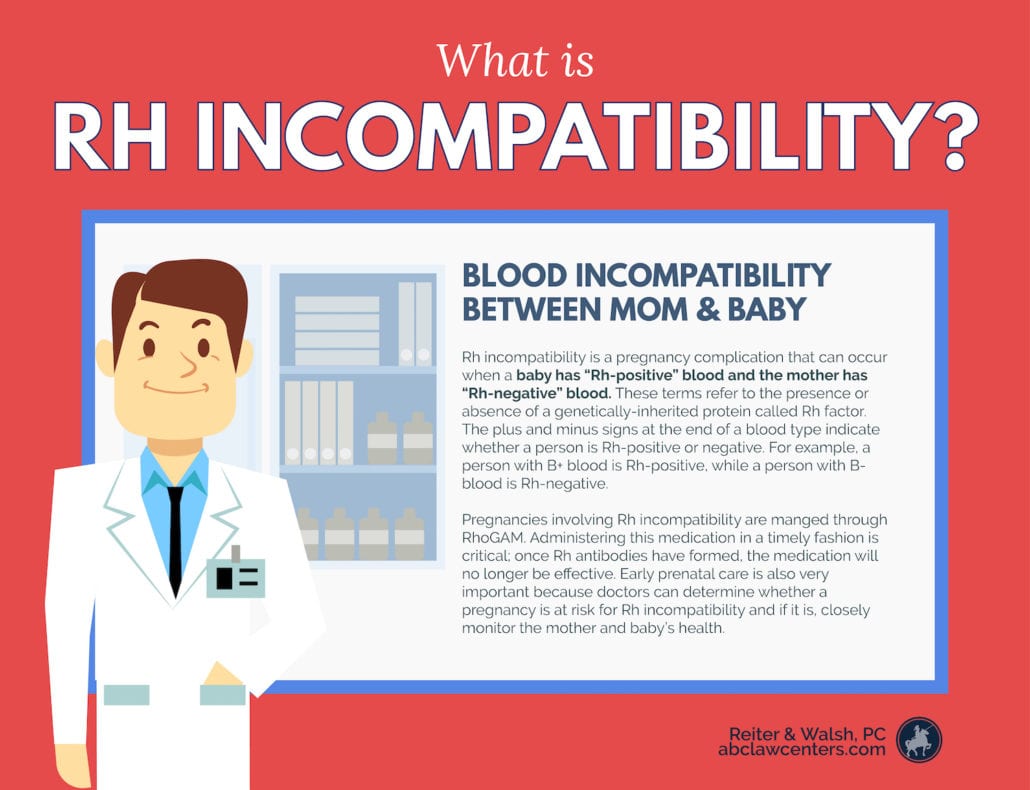Rh Incompatibility as a Pregnancy Complication
What is Rh Incompatibility?

Rh incompatibility is a pregnancy complication that can occur when a baby has Rh-positive blood and the mother has Rh-negative blood.
The terms “Rh-positive” and “Rh-negative” refer to the presence or absence of a genetically-inherited protein called Rh factor (1). As the American Red Cross explains, the plus and minus signs at the end of a blood type indicate whether a person is Rh-positive or Rh-negative. For example, a person with B+ blood is Rh-positive, while a person with B- blood is Rh-negative.
About Rh Incompatibility
Although there is a placental barrier that separates maternal and fetal blood, blood from the baby can still sometimes cross into the mother’s bloodstream. This is especially likely to occur during delivery. When crossover happens, the woman’s immune system will react to the baby’s blood as a foreign substance and produce antibodies that fight against it.
During a woman’s first pregnancy with Rh incompatibility, this is unlikely to cause a problem (1). Usually, the baby is born before there are enough antibodies to cause real harm. Once the antibodies are produced, however, they remain in the mother’s body long after the baby is born. If she has a second pregnancy with an Rh-positive fetus, the incompatibility may be dangerous. A first baby may also be at risk if the mother has previously been exposed to Rh-positive blood by other means (see “Risk factors for Rh incompatibility” below).

Rh incompatibility and hemolytic anemia
Hemolytic anemia is a condition in which the baby’s red blood cells are destroyed faster than they can be replenished. This happens when maternal antibodies cross the placenta and attack fetal red blood cells (1). Hemolytic anemia is very dangerous because red blood cells transport oxygen throughout the baby’s body.
Without enough oxygen, the baby may develop serious problems such as kernicterrus, hypoxic-ischemic encephalopathy (HIE) and resultant brain damage. Severe cases of hemolytic anemia can be fatal.
Risk Factors for Rh Incompatibility
Risk factors for Rh incompatibility include:
- Being an Rh-negative woman, and conceiving a baby with a man who is Rh-positive (that baby would have a 50% or greater chance of inheriting Rh-positive blood) (1)
- Prior exposure to Rh-positive blood, which could occur during:
- A previous birth with an Rh-positive baby
- An ectopic pregnancy, miscarriage, or abortion of an Rh-positive fetus (1, 2)
- An injection with a needle contaminated with Rh-positive blood
- A blood transfusion or stem cell transplant with an Rh-positive donor (medical professionals should know to avoid this)
- Tests during pregnancy that could expose the mother to the baby’s blood, such as amniocentesis and chorionic villus sampling. After these tests, doctors can administer a medication called Rh immune globulin, which can prevent an immune reaction.
Prevention of Rh Incompatibility
Women who are Rh-negative can be treated with Rh immune globulin shots to prevent them from making Rh antibodies that could affect a current or future pregnancy (2). Administering this medication in a timely fashion is critical because once Rh antibodies have formed, the medication will no longer be effective. Women should receive the shot at times when they are likely to be exposed to Rh-positive blood, such as if they have an amniocentesis or give birth to a baby with Rh-positive blood, etc (1). Rh-negative women will likely receive two immune globulin shots during the prenatal period, one around the 28th week of pregnancy and the other within 72 hours of birth (2).
Early prenatal care is also very important because doctors can determine whether a pregnancy is at risk for Rh incompatibility and if it is, closely monitor the mother and baby’s health (1). They can watch for signs of hemolytic anemia and provide treatment as necessary.
Signs and Symptoms of Rh Incompatibility
Rh incompatibility does not manifest any obvious signs or symptoms in pregnant women, but newborns may show signs of hemolytic anemia (1). These include:
- Jaundice, which can be recognized by a yellowing of the skin and the whites of the eyes. Rh incompatibility causes fetal red blood cells to die, and these dying cells release hemoglobin into the blood. The hemoglobin is then broken down into a compound called bilirubin, which is what causes the yellowish color in the baby. High levels of bilirubin can also cause a form of brain damage called kernicterus.
- Fluid buildup, which is an indication of heart failure. Without enough red blood cells to transport hemoglobin throughout the body, the infant’s heart will have to work harder, and the stress of this can lead to heart failure. The buildup of fluid as the result of heart failure is known as hydrops fetalis.
Diagnosis of Rh Incompatibility
Obstetricians can screen for Rh incompatibility by giving mothers a blood test to determine whether they are Rh-positive or Rh-negative (1). If they are Rh-negative, they can administer another blood test that screens for Rh antibodies. If a woman has Rh antibodies, it means she was previously exposed to Rh-positive blood, and that her current pregnancy may be in jeopardy if the fetus is Rh-positive. If the baby’s father is Rh-positive, or if it is not possible to determine his status, doctors may recommend a test called an amniocentesis to remove a sample of amniotic fluid and determine whether the baby is Rh-positive. (In rare cases, this can also cause exposure to Rh-positive blood; see “Risk Factors”). Once Rh incompatibility is known or suspected, medical professionals should administer additional tests for Rh antibodies later in pregnancy.
The likelihood that a fetus is suffering from hemolytic anemia due to Rh incompatibility can also be estimated through the results of an amniocentesis or antibody test (1). Hemolytic anemia can also be diagnosed via Doppler ultrasound.
Treatment for Hemolytic Anemia
In very mild cases, hemolytic anemia may not require treatment (1). When treatment is necessary, the baby can be given phototherapy, iron supplements and a medication called erythropoietin, which prompts the body to produce more red blood cells.
Severe hemolytic anemia requires a blood transfusion through the umbilical cord, or early induction of labor if the baby is almost full-term (1).
Newborns with severe hemolytic anemia may need a blood exchange transfusion, which involves removing the newborn’s blood and replacing it with blood or plasma from a donor. Babies with jaundice may also be treated with phototherapy to reduce the amount of bilirubin in their blood. This can prevent brain damage.


Rh Incompatibility, Hemolytic Anemia, and Medical Malpractice
Occasionally, doctors fail to prevent Rh incompatibility by not ordering screenings when they are indicated, or not treating women with Rh immune globulin when they are at risk of exposure to Rh-positive blood. They can also cause a woman who is Rh-negative to develop Rh antibodies through extremely negligent actions such as using contaminated needles or giving a transfusion of blood from an Rh-positive donor. Once Rh incompatibility and/or hemolytic anemia has been established, they may also fail to appropriately treat these conditions.
If you suspect that your child or loved one suffered from Rh incompatibility and hemolytic anemia as the result of medical negligence, you may want to consider pursuing legal action. The award-winning attorneys at ABC Law Centers: Birth Injury Lawyers focus exclusively on malpractice that occurs during pregnancy, birth, or the neonatal period. They also work closely with an in-house medical team, which enables them to delve deeper into complex medical issues. To find out if you have a case, please reach out for a free case review. We have numerous testimonials and multi-million dollar verdicts and settlements that attest to our success, and you pay nothing unless we win your case.
Featured Videos
Posterior Position
Hypoxic-Ischemic Encephalopathy (HIE)

Featured Testimonial
What Our
Clients Say…
After the traumatic birth of my son, I was left confused, afraid, and seeking answers. We needed someone we could trust and depend on. ABC Law Centers: Birth Injury Lawyers was just that.
- Michael
Helpful resources
- Rh Incompatibility. (n.d.). Retrieved February 6, 2019, from https://www.nhlbi.nih.gov/health-topics/rh-incompatibility
- Fuentes, A. (Ed.). (2018, October). Rh Incompatibility During Pregnancy (for Parents). Retrieved February 6, 2019, from https://kidshealth.org/en/parents/rh.html


